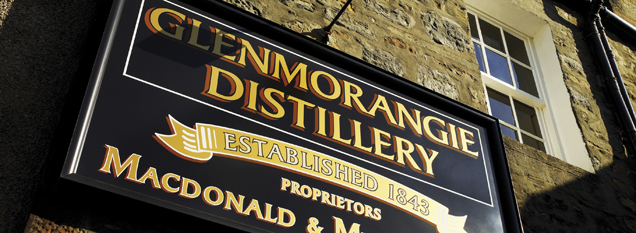Bill Lumsden is someone who really enjoys his job. Responsible for whisky creation for the famous Scottish distiller Glenmorangie, he’s known affectionately within the company as Dr Bill, someone who combines his impressive scientific pedigree with a love of both whisky and wine.
The world famous Glenmorangie classic, the single malt whisky so popular in the United States and throughout the world, was Dr Bill’s creation. It is a clever blend of some 150 flavours created in a time-honoured process at the distillery at Tain, in northern Scotland, and through years of maturation spent in ‘flavoured’ casks.
In addition to the special water source in the nearby Tarlogie Hills, whisky production at the Ross-shire distillery benefits from eight metre high stills, the tallest in Scotland and which, the company says, help produce the extremely light taste. The distillation process is undertaken by a staff of 16, known collectively as The Sixteen Men of Tain.
Glenmorangie has been the best selling single malt in Scotland almost continuously since 1983 and the distillery produces some ten million bottles a year. But the company continues to innovate.
NEW FLAVOURS
Dr Bill’s appreciation of wine is particularly important in this process as many of the new flavours he is developing for the Glenmorangie brand take their inspiration from some vineyard classics, the latest being the Artein private edition whisky. The secret behind the flavouring is one of wine connoisseur Dr Bill’s favourites, the Tuscany wine Sassicaya. Glenmorangie’s whisky creator has transported to the old wine-impregnated casks from the Italian vineyard to Scotland and filled them with the Artein whisky distillate for its final phase of maturation. Officially labelled as a 15-year-old whisky, in reality it combines both 21-year-old Glenmorangie and 15-year-old Glenmorangie as the base of the limited edition product.
At Glenmorangie this process is called ‘extra maturation’ and engineering the transfer of flavours from old casks which once contained wines, sherries or other whiskies is part of the distillery’s inhouse expertise.
ART OF CASKS
Karen Fullerton, Glenmorangie’s globe-trotting product ambassador explains that two thirds of the flavour of a good Glenmorangie whisky comes from the cask. “Our obsession with finding the perfect wood in which to super mature Glenmorangie has seen us travel far and wide to get what we need.”
The preferred basic casks come from the United States, made typically from white oak. These slow growth oak tees are nurtured in the company’s own forest in the Ozark Mountains of Missouri. The trees are selected for their highly porous qualities before the oak is air seasoned for at least two years, heavily toasting and lightly charring it to maximize the flavour potential. The resulting casks are leased to Bourbon or Tennessee producers for four years and then brought back to Scotland.
“Sixty percent of the flavour comes from the cask which is why we are passionately, and scientifically, committed to creating the perfect casks in which to mature our precious spirit,” Karen Fullerton explains.
A final stage for some of the whiskies is chill filtering, to remove elements that will cloud on contact with water. “For our extra-matured range such as Artein, we choose not to carry out this process so that they can maintain their added body, taste and texture,” she adds.







